


A set (in mathematics) is described as a collection of objects or things that share a common well-defined property.
This may bring to mind the thought of a stamp or coin collection. Or perhaps the image of grouping any number of objects together. For example, asking students to differentiate between animals that hibernate and animals that do not, and grouping them accordingly on a chart. All these examples are a great way to think of a set.
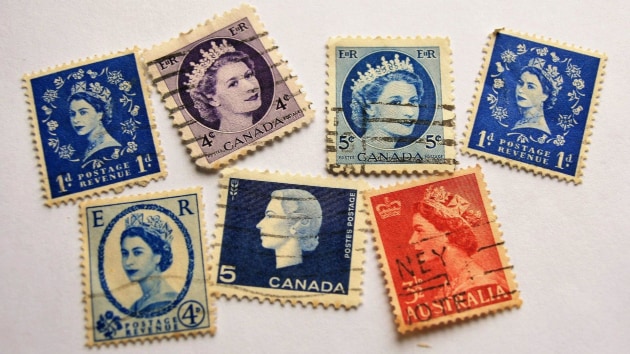
In a set, the parameters, or characteristics that classify an object as being part of a particular set, must be well defined. For example, it is easy to group children in a classroom according to the month each child is born. But it would be difficult to make a set to include funny jokes since what is funny to one person may not be funny to another person.
Believe it or not, sets can be found all around us. People like to group things according to common properties because it makes it easier to find things and easier to use. Here are some examples where you can find sets every day:
Kitchen
The kitchen is a great place to organize and find sets. Eating utensils are separate from plates and bowls. Cereals, rice, and other grains are likely stored separately from fruits and vegetables. Pots and pans are likely to be stored in a different drawer away from aprons and tablecloths.

The Library
Imagine having to find a book without the help of sets! Fortunately, a system is used that makes finding a particular book relatively easy.
Libraries use either the Library of Congress Classification System or the Dewey Decimal Classification System to organize their books. Books, and other library materials like magazines and newspapers, are grouped together by discipline or field of study. This ensures that science books are grouped with other science books, maths books are grouped with maths books, and children’s books are grouped together with other children’s books.

Department Store
Have you ever thought about what shopping would be like if there was no grouping of similar items? For example, what if hats were grouped together with electronics?
Department stores organize different areas so shoppers can quickly find what they are looking for and make purchases.
The format of grouping also applies to online shopping. The menu bar lists the various categories, and then items are grouped together depending on where they fit in those categories.

Twinkl Website
Yep, even websites like Twinkl are an example of sets. On the Twinkl website, learning resources are grouped together according to grade level and subject. If you are looking for maths worksheets for the third grade you would look in a different place from if you were looking for social studies activities. Then there are separate areas for blogs and teaching wiki pages like this one.
The concept of sets is introduced at an early age through the use of Venn diagrams, Euler diagrams, Carroll diagrams, and other sorting activities. However, the focus is not on numbers but on the concept of grouping. Sets are therefore not restricted to maths lessons and instead can be used for making comparisons in history, English, and science activities.
It is important for children to learn the concept of grouping as this practice becomes important in advanced mathematics in later years. There are a number of sorting activities available on our website to help children gain an understanding of using common properties to group objects. These activities can be used in a wide range of lessons and can be made to suit your learning objectives.
The advanced mathematical concept of set theory is then introduced to students in secondary school. This is when the thinking of sets as a group of objects sharing a defined characteristic moves to a more maths-focused approach.
For now, we will provide a brief overview of the notions of a set and show how sets are written.
We have already defined a set as a group of objects that share a common characteristic. For example, a set can be a collection of fruit.
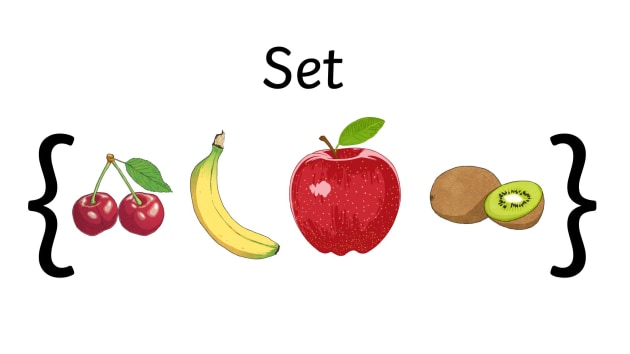
Within a set, each individual object is known as a member or an element. No two elements in a set are identical; each is unique.
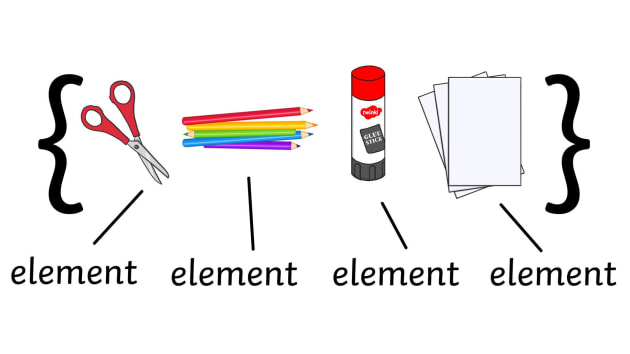
When listing elements in a set, each element is separated by a comma. It is very similar to the act of making a shopping list. For example, if one wanted to write a shopping list in the form of a set, it would be written as follows: {bread, milk, eggs, butter, pears, broccoli, tomatoes}.
You are probably wondering what the { } symbols are all about. Sets are usually recognized in text by the use of curly brackets called “set brackets” or “braces”. These set brackets contain the group; anything outside these brackets is not a part of the group.
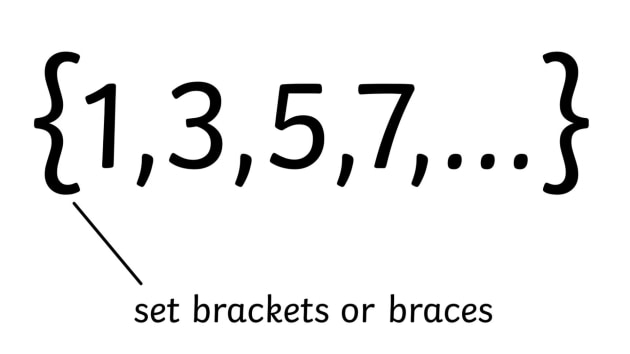
Finally, the three dots together at the end are called the ellipsis and means “to continue”. It is important to note that the ellipsis does not always need to be at the end, nor do sets need to contain an ellipsis.
Sometimes the ellipsis is placed in the middle to save having to write out every element in the set. That middle ellipsis means that the list is expected to follow the defined pattern until the next listed element. Other times the ellipsis is placed at the beginning to indicate that there is an infinite amount leading up to the set. An ellipsis that is placed at the beginning or at the end means that the set has an endless list of elements.
Standard symbols and particular writing forms are used in sets to help save time and writing space.
Capital letters in italic are used to stand for a whole set.
For example, A = {1,2,3,4,5,6,7}. A is the set and the numbers 1,2,3,4,5,6, and 7 are the elements.
Some other common symbols and their meanings are listed below. Mathematical letter symbols are typed in bold or blackboard bold typeface.
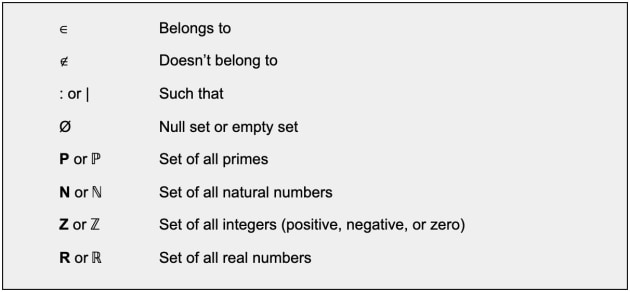
Positive or negative sets are sometimes represented with a superscript plus or minus sign. For example, you can write the letter symbol as P⁺ or ℙ⁺ if you wanted to represent a set of all positive prime numbers.
There are three ways to write or represent a set: statement form, roster form, and set-builder form.
Statement Form or Semantic Definition
This is the simplest way to introduce the concept of a set and it’s how elementary school students are introduced to the idea of grouping. Here, the rule of the elements is written as a well-defined description.
|
For example: A is the set of all letters of the English alphabet. B is the set of all even numbers greater than 10 and less than 34. C is the set of all state capitals of the United States. |
Roster Form
This is the form where elements of a set are listed between curly brackets and are separated by commas.
|
For example: D = {4,6,8,10} The set of all even numbers between 2 and 12 not inclusive. E = {2,3,5,7,11,13,17,19,23,29,31} The set of the first 11 prime numbers. F = {Monday, Tuesday, Wednesday, Thursday, Friday, Saturday, Sunday} The set of the days of the week. |
Set-Builder Form
This form of writing sets is best described as an example of shorthand. Sets are not limited by the number of elements and therefore can contain hundreds, thousands, and even millions of elements. Instead of taking multiple days or weeks to list all the elements in the set, you can quickly define the property of the set that the elements must follow.
The description or rule of the set is written within the pair of curly brackets. Elements, represented by the symbol x or another variable, must meet the rule to be included in the set.
A simple set, or listing, might be written as {7,8,9,10}. But what if we wanted to include all real numbers? {7,7.1,7.11,7.111,...}. The listing would just go on and on. Instead, the easiest way to write this set would be to use Set-Builder Form.
|
For example: G = {x∈ℝ | 7≤x≤10} The set of all real numbers between 7 and 10 inclusive. Here is another example of Set-Builder Form: H = {x∈ℤ | x≥10} The set of all integers, such that x is an integer equal or greater than 10. |
As demonstrated, this form is very useful when there are a large number of elements assigned to a group.
Sets are equal if and only if they have exactly the same elements. Sometimes the sets are written differently, perhaps one in statement form and the other in roster form, so it is important to consider both sets carefully before saying whether or not they are equal. When sets are equal we use the equality sign (=) between the sets.
|
For example: A is a set that contains the first six months of the Gregorian, or Western, calendar. B = {January, February, March, April, May, June} Set A is equal to set B because they both contain the first six months of the year. This would be written as: A = B Another example: C = {10, 11, 12, 13, 14} D = {14, 13, 12, 11, 10} Set C is equal to set D because they contain precisely the same element members even though they are presented in a different order. Therefore, the answer is: C = D |
Sets are equivalent when they have the same number of elements, even when the elements are completely different. The number of distinct elements within a set is called the cardinal number. The cardinal number is written as n(set name). When sets are equivalent we use ↔ between the sets.
|
For example: E = {1, 2, 3} F = {red, blue, yellow} Both set E and set F have three distinct elements. The cardinal number is therefore written as n(E) = 3 and n(F) = 3. Since the cardinal numbers are the same, E and F are equivalent sets: E ↔ F |
While a set makes up the entire collection of items that share a common property, a subset is defined as a set that is made up of all or a portion of the elements in the original set.
|
For example: A = {2, 4, 6, 8, 10, 12} B = {2, 4, 6} Set B is a subset of set A because all elements of set B are also elements of set A. |
It can also be said that set B is a proper subset of set A because every element of B is an element of A and there are elements of A that are not elements of B. The Euler diagram below is a good way to show the proper subset.
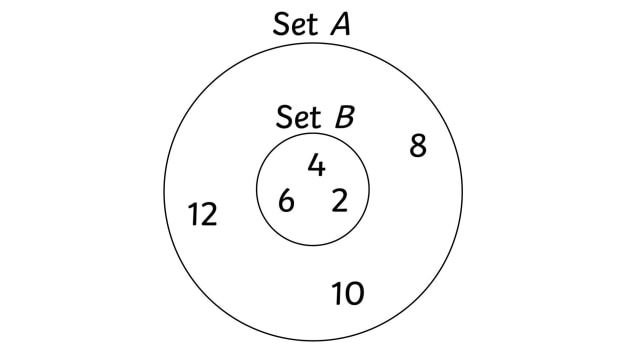
On many occasions, sets are compared to one another to see how the elements are shared. We use the terms union and intersection to determine which elements to focus on.
When we say there is a union of sets, we are looking at all the elements that are a member of at least one of the sets.
|
For example: Set C = {1, 3, 5, 7, 9, 11} Set D = {7, 9, 11, 13, 15, 17} The union of the sets would include all the elements and would be written as follows: C ⋃ D = {1, 3, 5, 7, 9, 11, 13, 15, 17} |
When we say there is an intersection of sets, we are looking at the elements that are a member of all the sets.
|
Using the same example above: Set C = {1, 3, 5, 7, 9, 11} Set D = {7, 9, 11, 13, 15, 17} The intersection of the sets would include those elements which are members of both set C and set D, and would be written as follows: C ∩ D = {7, 9, 11} |
The Venn diagram is a great way to show the union and intersection of sets.
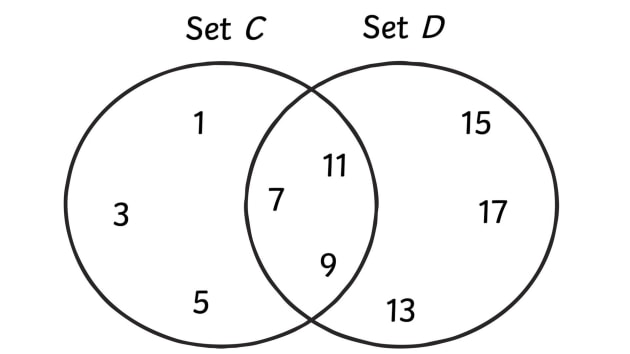
There is some research exploring the idea of introducing the basic vocabulary and concepts of set mathematics to elementary school students. Introducing the formats and terminology at an earlier age may help students as they progress through to advanced maths in later years.
Introducing the concept of sets could be as simple as asking students to write the first 12 multiples of an integer, such as 4, as a set: {4, 8, 12, 16, 20, 24, 28, 32, 36, 40, 44, 48.}
Or perhaps you can ask students to organize items, or elements, in a Venn diagram.
|
For example: John likes eating pizza, ice cream, spinach, carrots, pasta, apples, and cake. Martha likes eating burgers, salmon, peas, pears, pasta, apples, and cake. |
In a Venn diagram, the statements would be represented as follows:
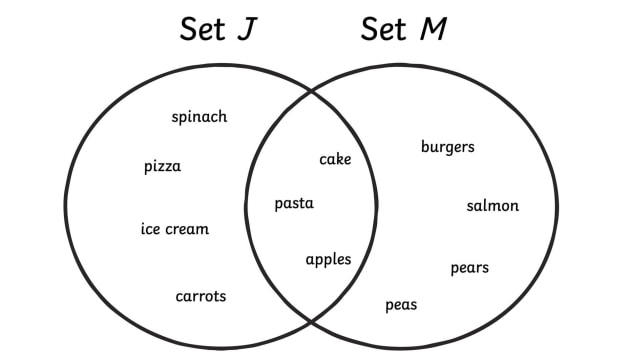
|
Solving the example: Set J stands for John and set M stands for Martha. They can be written as: J = {pizza, ice cream, spinach, carrots, pasta, apples, cake} M = {burgers, salmon, peas, pears, pasta, apples, cake} Next, the sets can be further explored: The cardinal number is n(J) = 7 and n(M) = 7 and even though the sets are not equal, they are equivalent. Therefore, J ↔ M The union of sets shows all the elements in the Venn diagram: J ⋃ M = {pizza, ice cream, spinach, carrots, pasta, apples, cake, burgers, salmon, peas, pears} The intersection of sets, or the elements both liked by John and Martha: J ∩ M = {pasta, apples, cake} |
Remember those equivalent sets as well as the unions and intersections of sets? They can be used in examples even when numbers and maths are not the focus.
Set mathematics puts a visual spin on maths and encourages students to look at maths in a new way.
See what examples of sets you can find around your classroom, your home, or even within any school assignment.